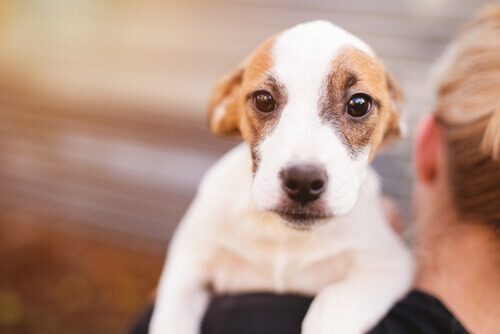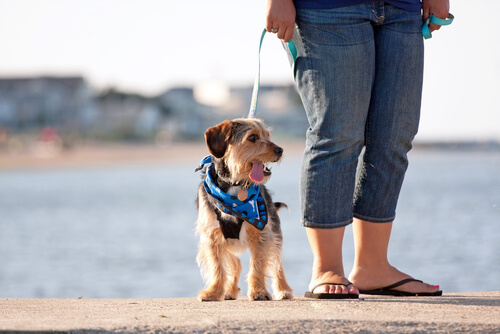Keeping Your Dog Warm: A Complete Guide for Cold Weather


Written and verified by the lawyer Francisco María García
Joint and osseous diseases are especially aggravated during cold weather. Therefore, keeping your dog warm and shielding them from the cold is essential in preparing your pet for winter.
How Can You Know Whether Your Dog is Cold?
Ideally, you should prevent your dog from feeling cold as quickly as possible, which keeps their body from being damaged.
As a general rule, a dog shows that it is cold by trembling. However, it is particularly important to be aware of the other symptoms of coldness that your pet can exhibit:

- Decreased respiratory rate (usually the dog stops panting)
- Slowness or fatigue
- Exhaustion or excessive sleepiness
- Dry skin and mucous membranes (may have cuts or scratches)
- Canine diseases associated with the cold
Canine Diseases Associated with Cold Weather
Keeping your dog warm is the most efficient way to avoid the diseases associated with this type of climate.
Now we will go over the main pathological processes associated or aggravated by the cold that can affect our pets.
Colds
Dogs can catch colds too and their symptoms are very similar to ours. A cold and wet nose, red eyes, fever, congestion, fatigue and sneezing.
Infectious tracheobronchitis (“kennel cough” or “canine cough”)
This disease is caused by a virus with a high capacity for mutation. It is most contagious starting in the fall and remains highly contagious throughout the winter. Therefore, it is important start keeping your dog warm as soon as summer is over.
It is not a serious pathology, but it is usually difficult to heal and can be very uncomfortable for the animal. Meaning that, if your dog has cough, fever, vomiting or congestion, you should them to the vet immediately.
The evolution of these pathological conditions can lead to more severe respiratory diseases. Bronchitis, pharyngitis, laryngitis and pneumonia can start with a simple cold.
Bone and/or Joint Diseases
Joint diseases tend to manifest themselves more severely during the winter. Mainly, when the cold weather is accompanied by humidity.
Older dogs, or those with diseases such as hip and elbow dysplasia, are the most vulnerable. That is why they need reinforced protection.
Which Breeds Adapt the Best to the Cold and Which Ones Need the Most Care?
Many people believe that dogs with long, abundant fur do not feel the cold. This is a myth however, since all dogs have the ability to feel either hot or cold. Their resistance to temperature changes varies according to their size, breed and fur.
Siberian Huskies, Shar-peis, Samoyeds, Alaskan malamutes and Chow-Chows are the best-known examples. These dogs tend to have a remarkable resistance to harsh temperatures and to the cold. However, this does not mean that they do not need care during the winter.
Smaller, furry dogs are often highly vulnerable to cold climates. Their bodies are more fragile and are not prepared to survive the harsh weather, which means that they also get sick much more quickly.
The breeds of dogs that need more care in the cold are: Yorkshire terriers, Pinschers, French Bulldogs, Boston Terriers, Pugs, Chihuahua, Miniature Bull Terriers and Chinese Crested Dogs.
Keeping Your Dog Warm: 6 Practical and Effective Tips
1. Condition their Environment
In countries with severe winters, it is essential to maintain your home at an adequate temperature. Ideally, the temperature should remain between 19ºC and 25ºC.
Our pet’s sleeping and resting spaces must have a dry, thick, clean blanket.
2. Dress Your Dog in Clothing and Garments that Will Help Keep Them Warm
There are sweaters, capes and waterproof coats for dogs of all sizes and ages.

3. Take Walks Together in the Sun
Cold weather should not prevent us from getting some exercise with our best friend. Actually, physical activity helps regulate body temperature and is very welcome in the winter. But ideally, you want to make your walks during the morning when there’s a chance of there being some sunlight.
4. Build a Dog House
A large number of pets sleep outside the house. It is important to build or buy a house for your best friend so you are not leaving them outdoors during the winter.
5. Moisturizing Creams
Dog’s ears and legs are very sensitive to cold weather and can dry out and/or crack. There are specific moisturizers for dogs that help prevent and treat this problem. Do not use human cosmetics on your pet.
6. Massages and Warm Compresses
Puppies and older dogs can often have stiff muscles because of the cold. It is recommended to massage the affected area with great care and apply a warm compress for 15 minutes.
To keep your dog from being affected further by the cold, it is necessary to respect the due dates on their vaccinations and deworming records. Otherwise, their immune system can weaken and become more vulnerable to all kinds of diseases.
This text is provided for informational purposes only and does not replace consultation with a professional. If in doubt, consult your specialist.